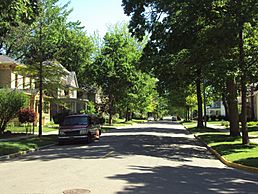Dennis–State Streets Historic District facts for kids
|
Dennis–State Streets Historic District
|
|
 |
|
| Location | Adrian, Michigan |
|---|---|
| Architectural style | Mix of Greek Revival, Gothic Revival, Italianate, Queen Anne, and Shingle |
| NRHP reference No. | 75002170 |
Quick facts for kids Significant dates |
|
| Added to NRHP | April 14, 1975 |
The Dennis–State Streets Historic District is a special neighborhood in Adrian, Michigan. It's known for its many old and beautiful homes. This area was officially recognized as a Michigan Historic Site in 1974. A year later, it was added to the National Register of Historic Places. This means it's a very important place for history in the United States! In 1979, one more historic building was added to the district.
Contents
Exploring the Historic District
This historic neighborhood is located in Adrian, Michigan. It's just south of the main downtown area. The district is bordered by Union Street to the north and some railroad tracks to the south. State Street is on its east side, and Dennis Street is on its west side. West Michigan Street also runs through the area. All the homes on both sides of these streets are part of the district.
A Look Back in Time
The land for this district was first settled around 1826. The neighborhood itself was planned out in 1844. It was called "Berry's Southern Addition." Some of the oldest homes you can see today were built in the 1840s. At that time, Adrian was growing fast. It was connected by railroad to other cities like Toledo and Monroe. This made Adrian the sixth-largest city in Michigan!
Because of its great location, many people wanted to live here. It was easy to walk to Adrian's shops, churches, and factories. Over the years, some older homes were updated. Others were replaced with newer styles.
Amazing Architecture
This neighborhood is a fantastic place to see many different types of old houses. They were built in popular styles from the 1800s and early 1900s. You can find homes in styles like:
- Octagon (shaped like an eight-sided figure)
- Foursquare (a simple, boxy design)
- Greek Revival (like ancient Greek temples)
- Gothic Revival (with pointed arches and steep roofs)
- Italianate (inspired by Italian villas)
- Queen Anne (colorful and decorative)
- Shingle (covered in wooden shingles)
You can learn more about these styles on a self-guided walking tour or Peter Barr's website. The district is also great for walking. It's a quiet area, away from heavy traffic.
Famous People Who Lived Here
Many well-known people once called this neighborhood home. Here are a few:
- Thomas Edison: The famous inventor worked as a telegraph operator in Adrian in 1864. He stayed at the Chittenden House on State Street.
- Samuel W. Raymond: He was Henry Ford's brother-in-law. Samuel owned a Ford Garage and lived on State Street.
- J. Wallace Page: He invented the woven wire fence. J. Wallace Page lived at 510 State Street.
- W. H. Burnham: He was the President of Lamb Fence Company. His home on East Church Street was also lived in by banker W. H. Waldby and merchant George L. Bidwell.
- Ollie E. Mott: He owned the Nu-Way Stretch Suspender Company and lived on State Street.
- Isabella and William Cocker: They lived on Dennis Street. They received a large inheritance from Elihu L. Clark.
- The Stevenson Family: Three generations of this family lived on Dennis Street. They were in the lumber and coal business.
- Byron Shaw and Samuel Hart: These two owned the Hart & Shaw Drugstore. They both lived in the district at different times.
- J. H. Champion: He was the editor of the Adrian Watchtower newspaper. He lived on Winter Street.



